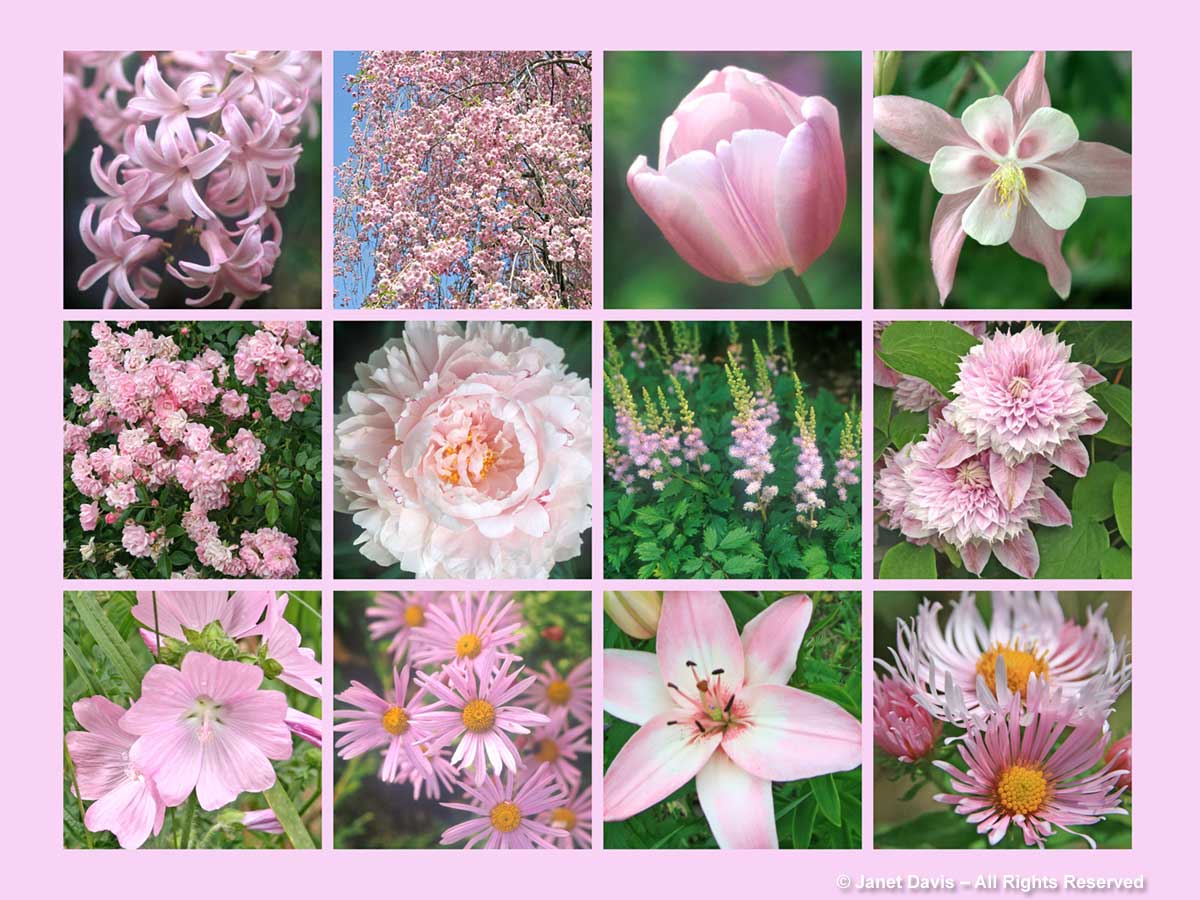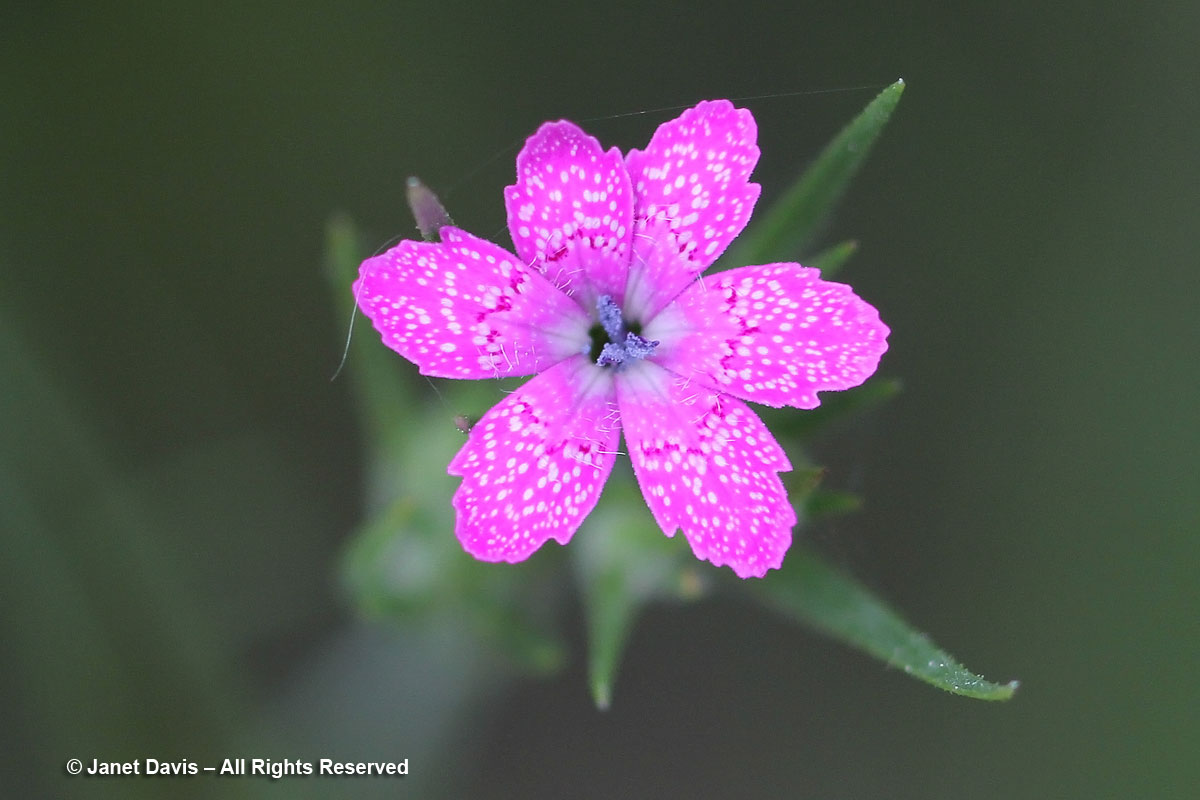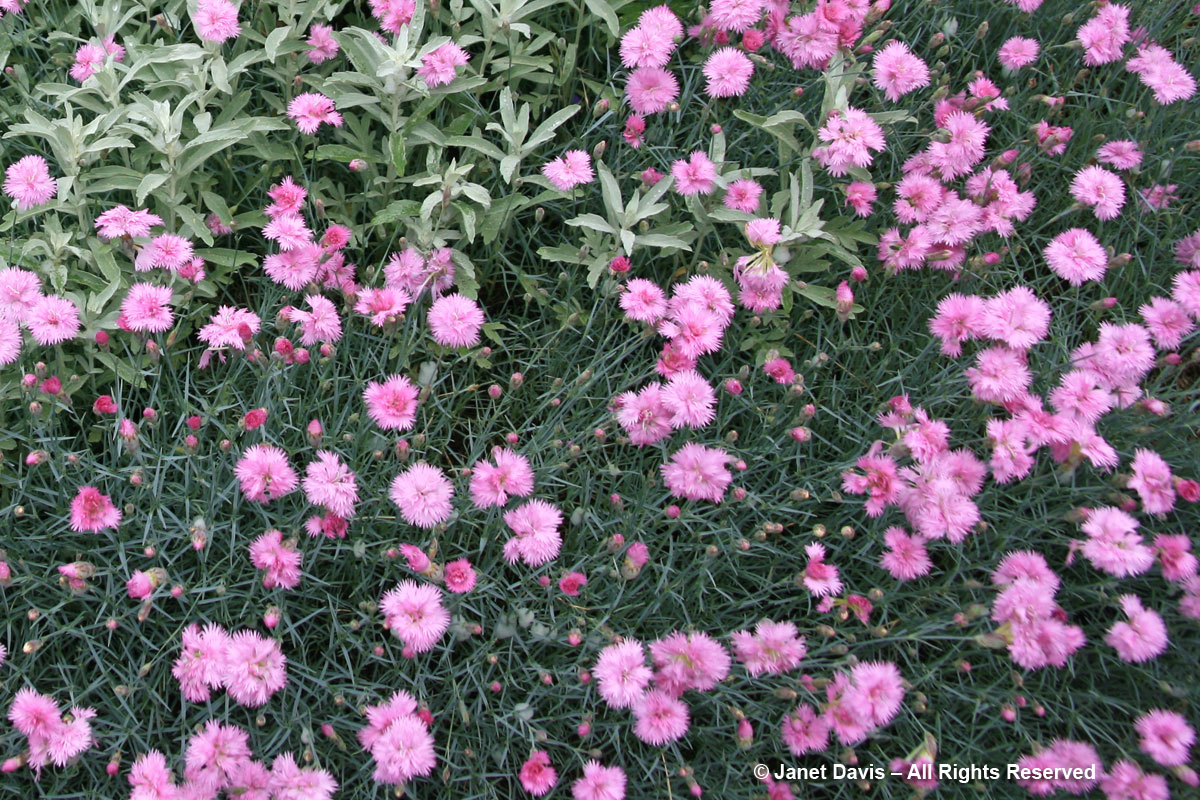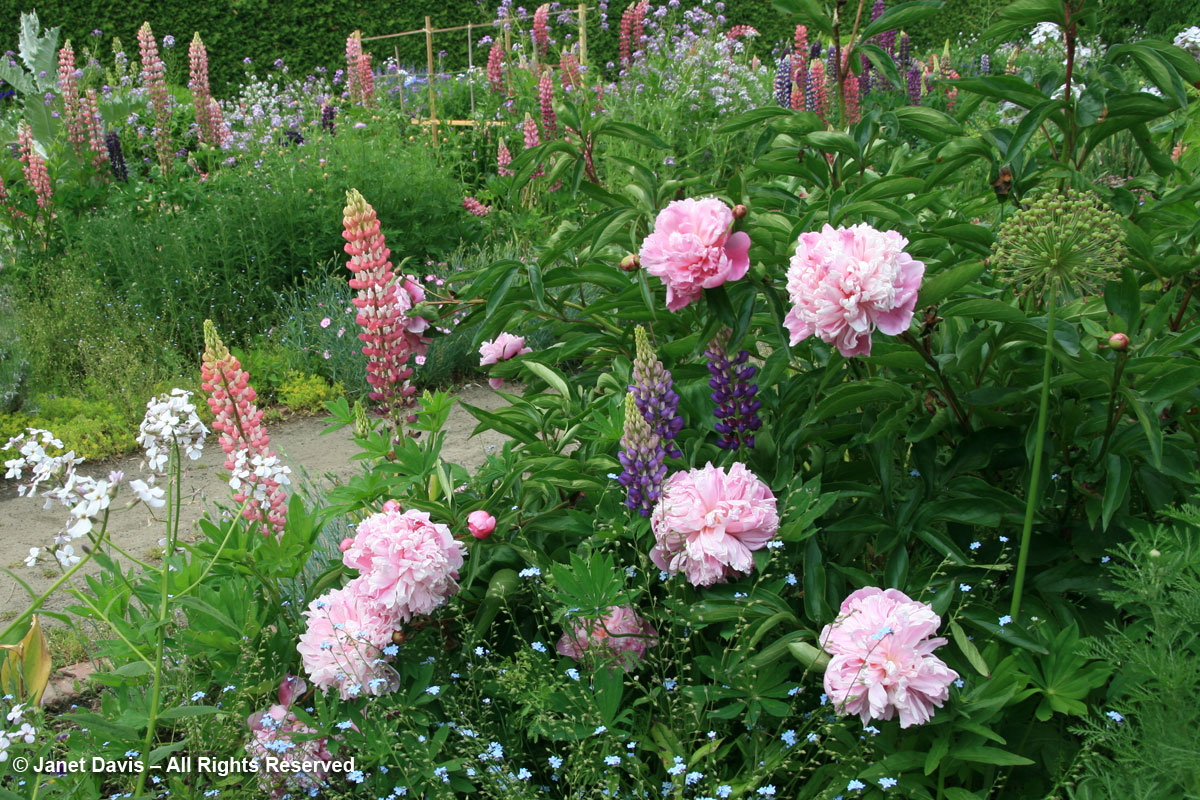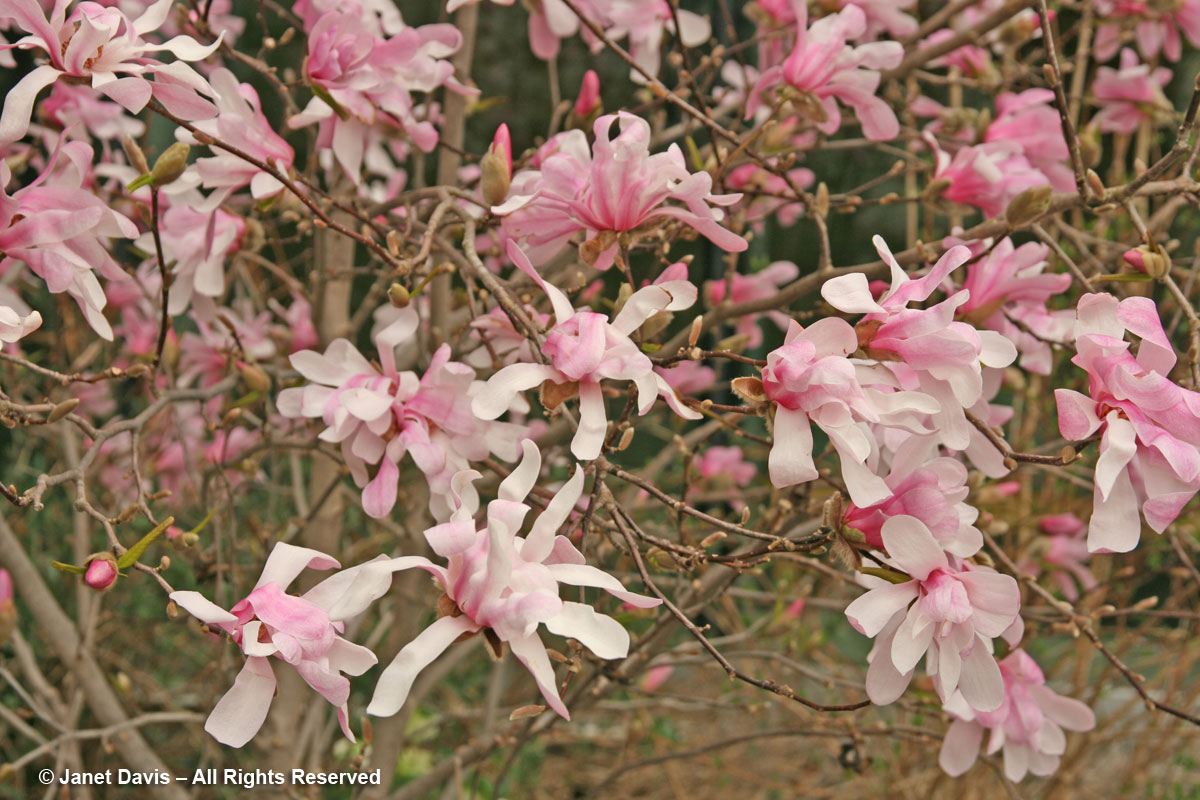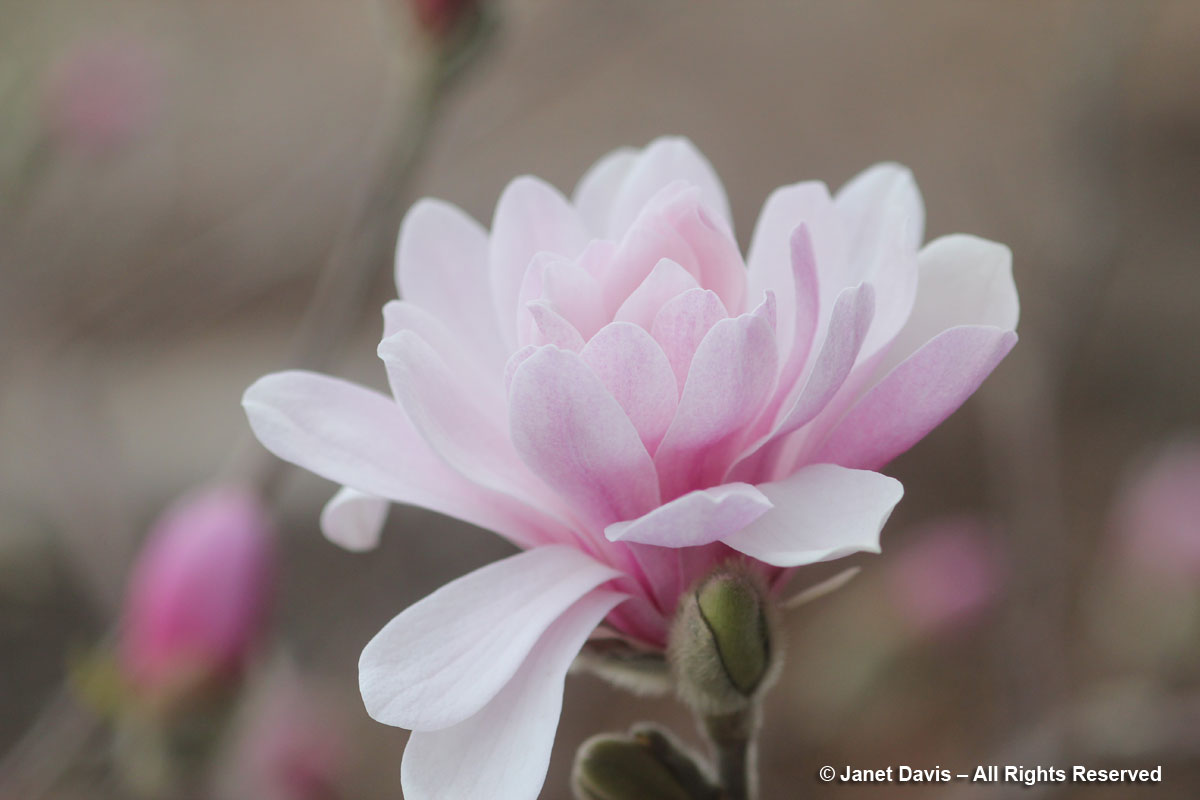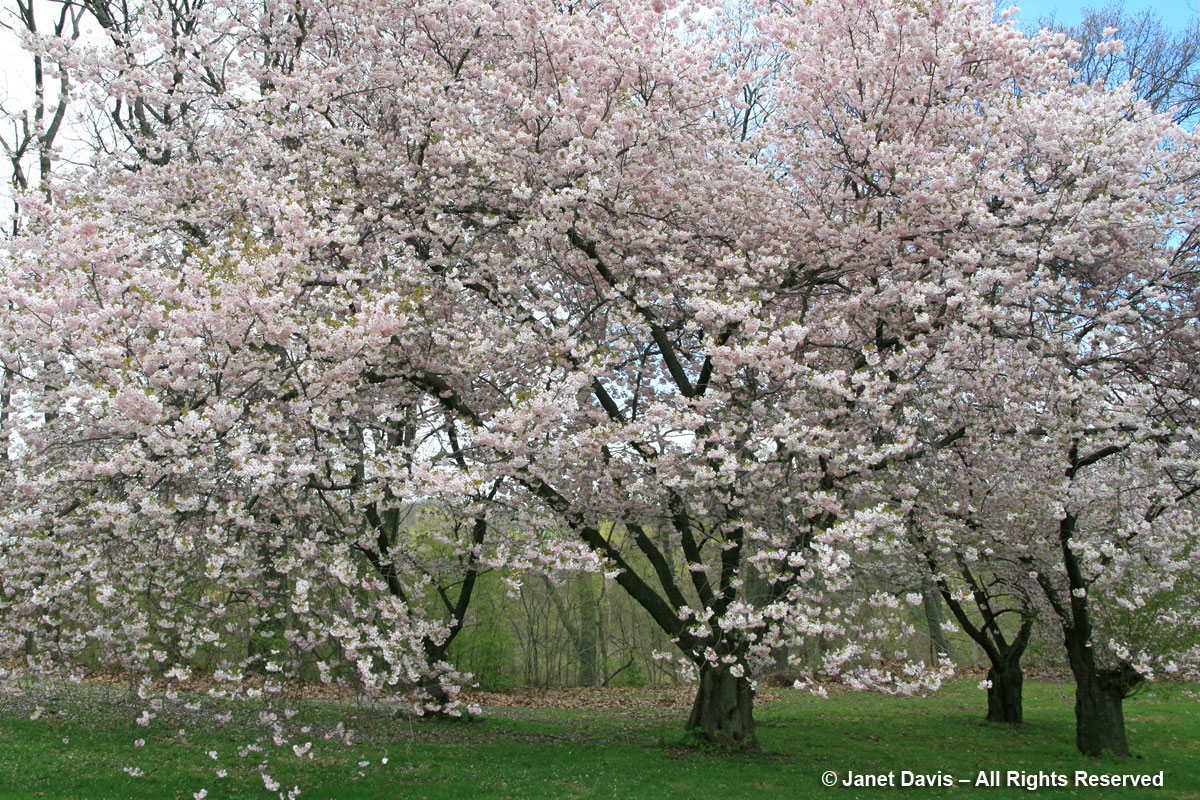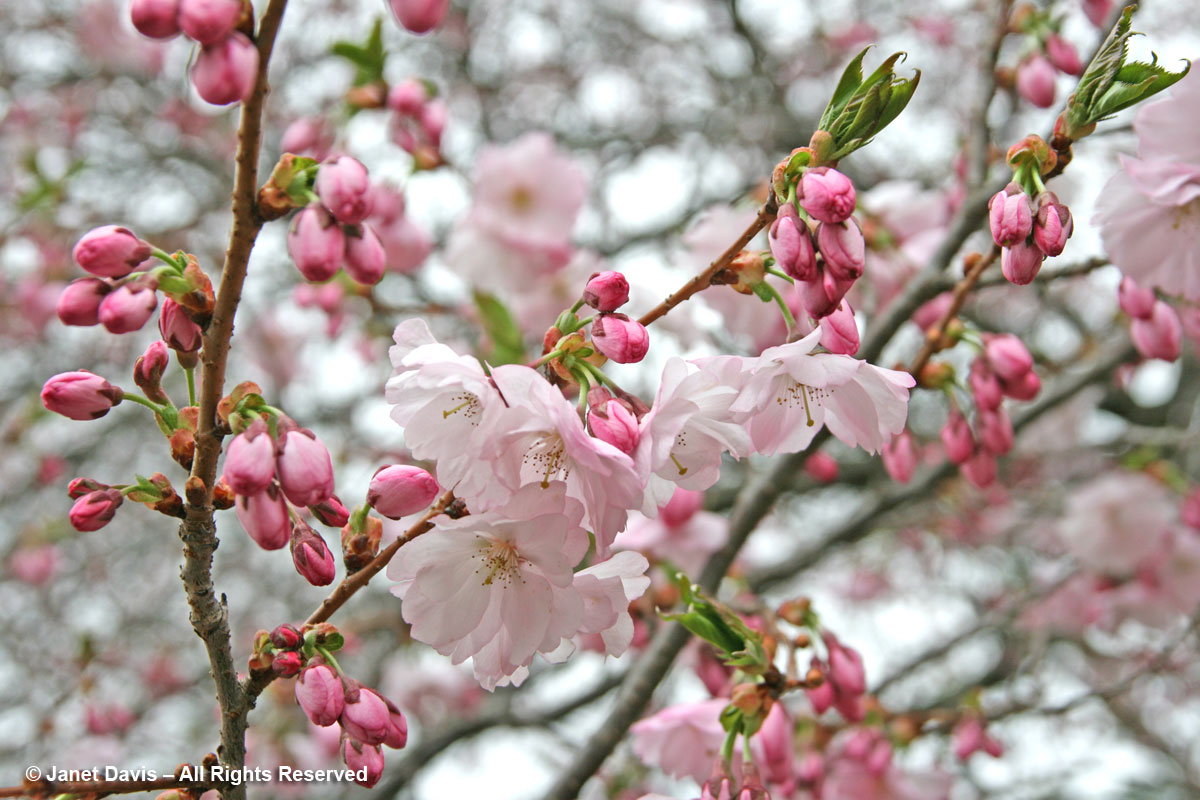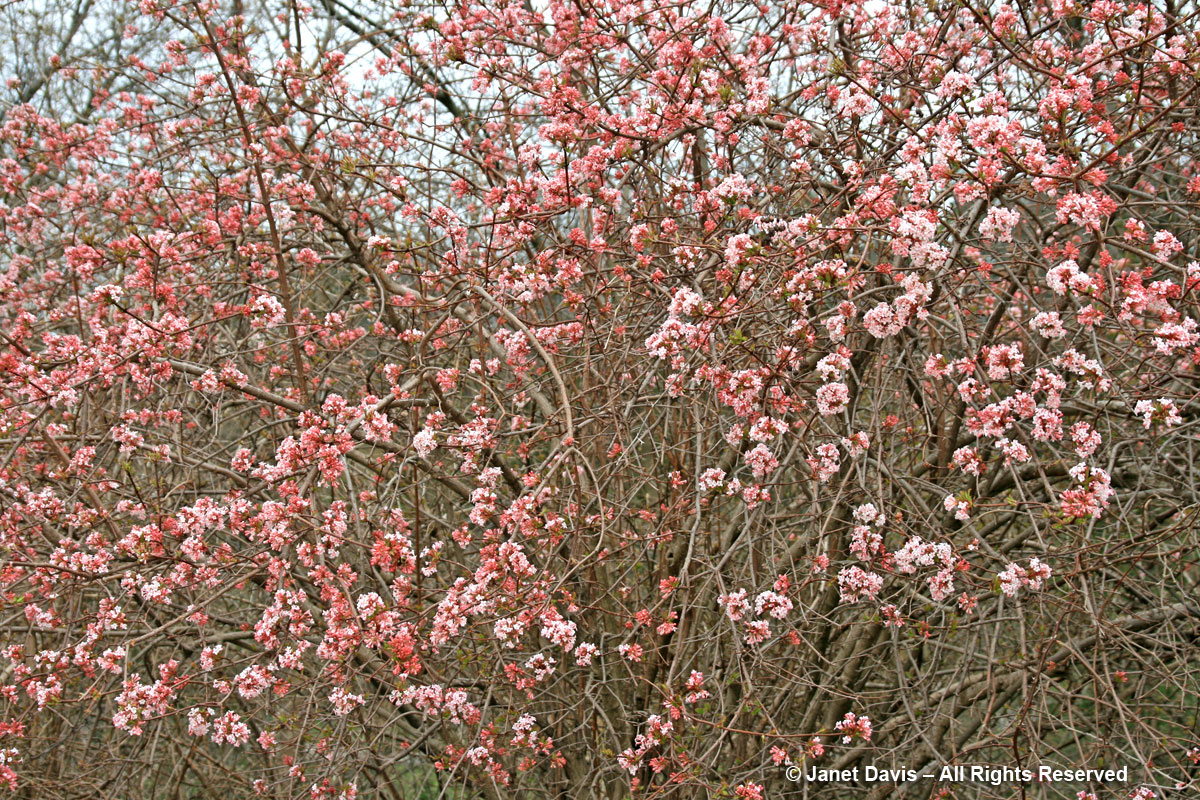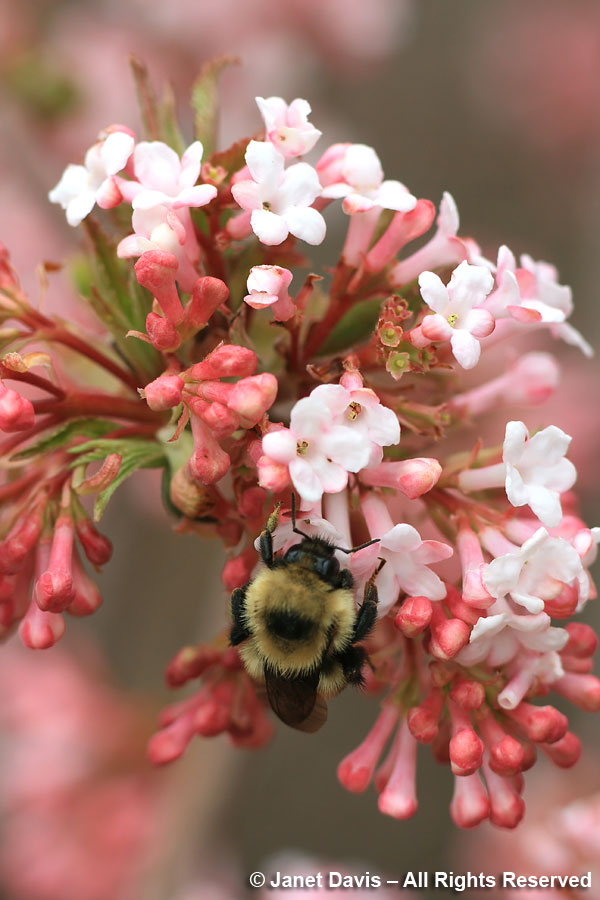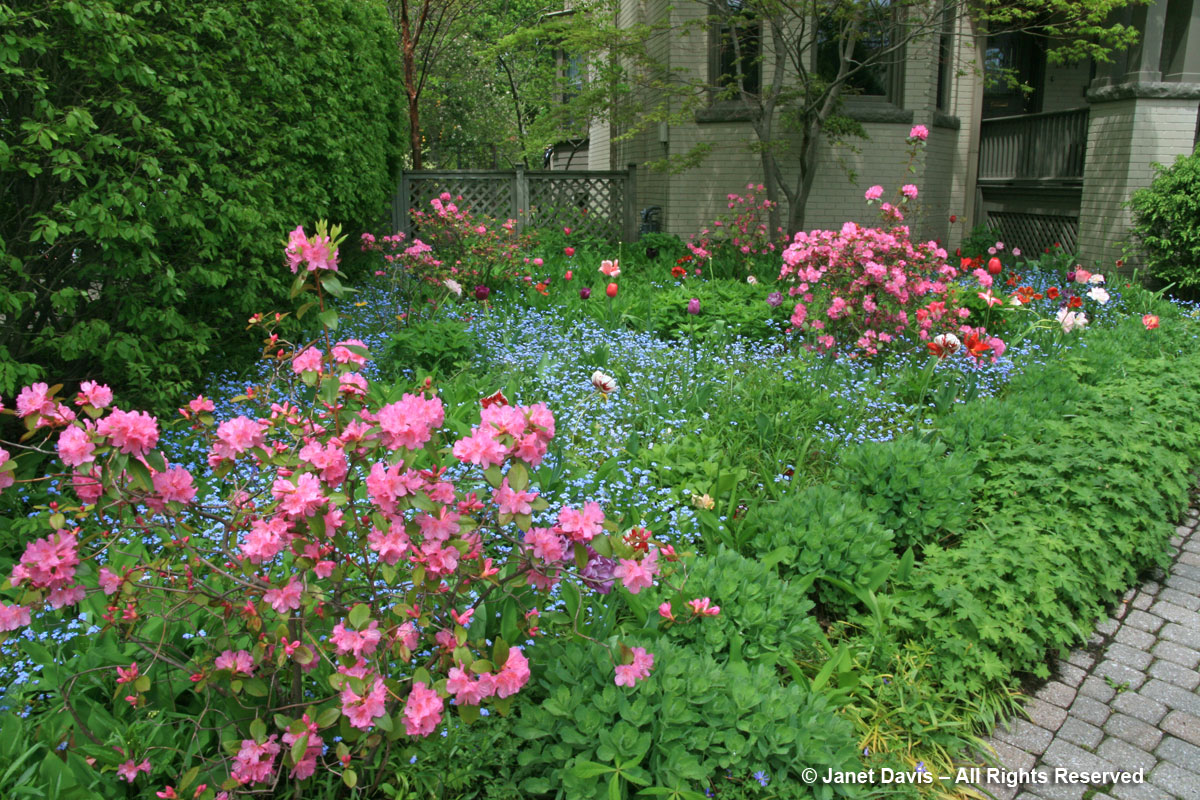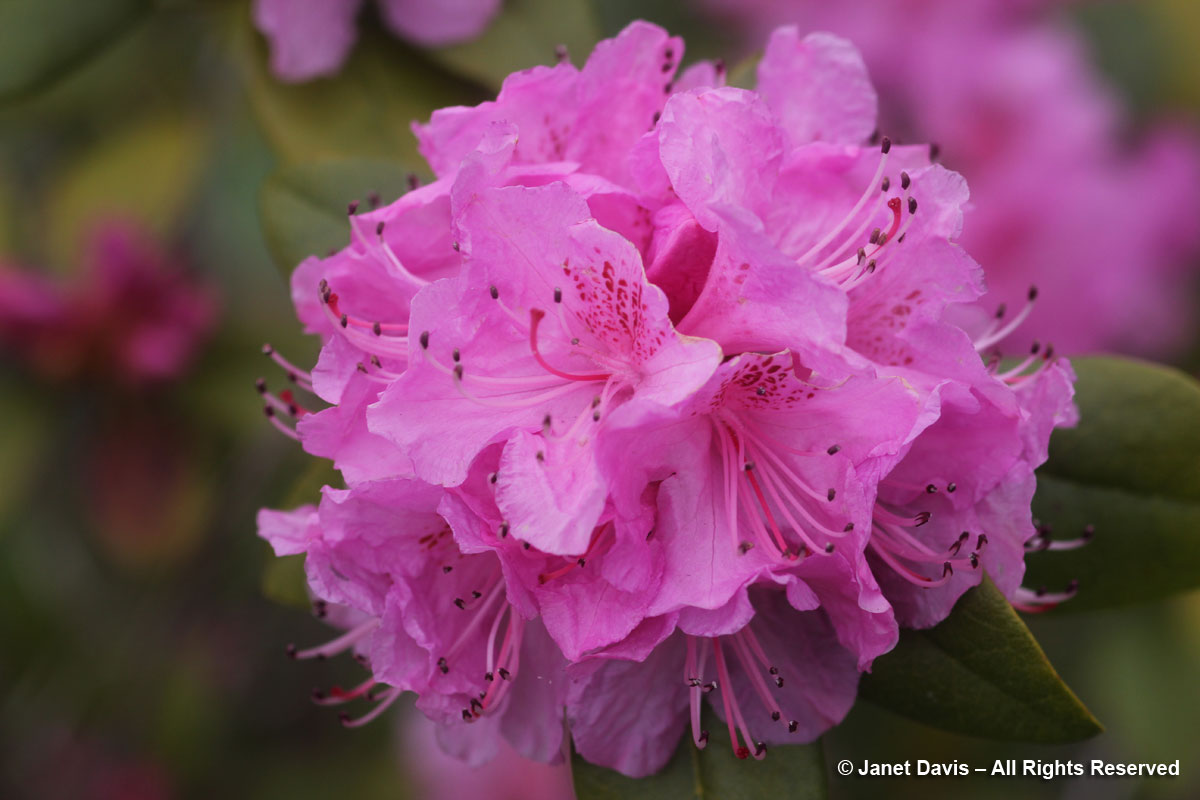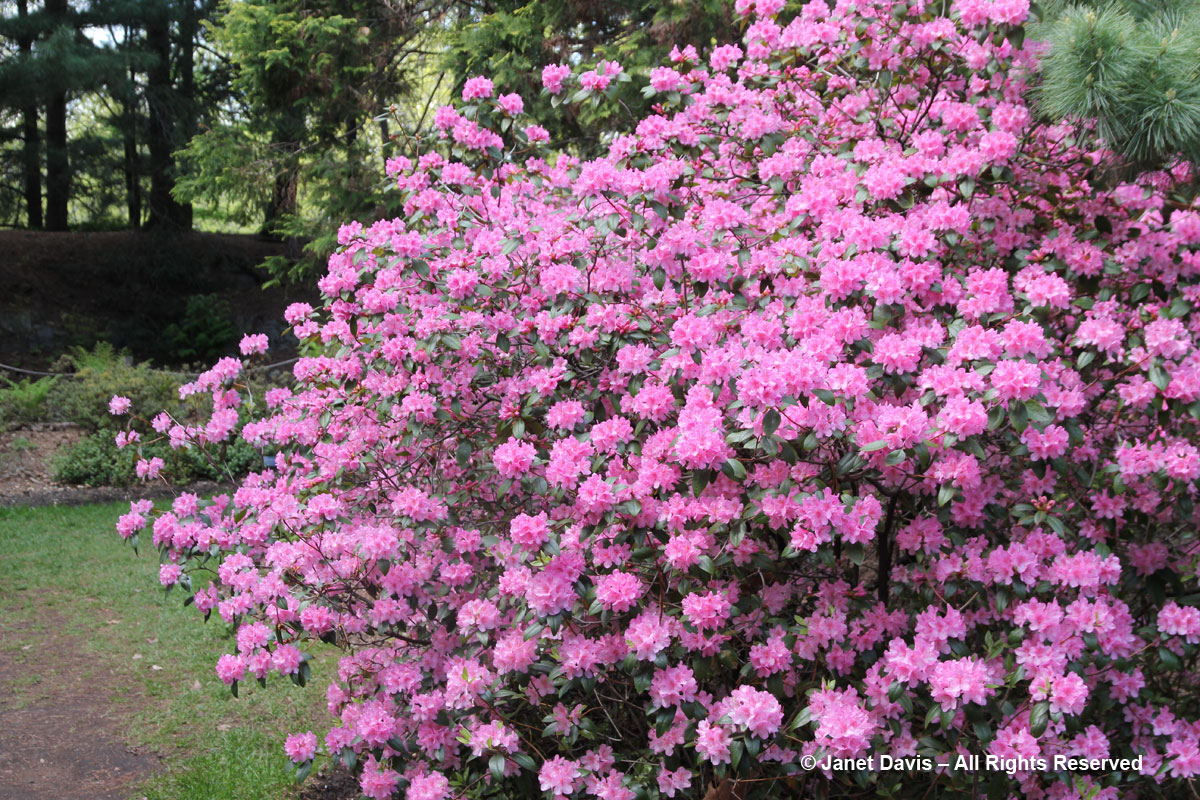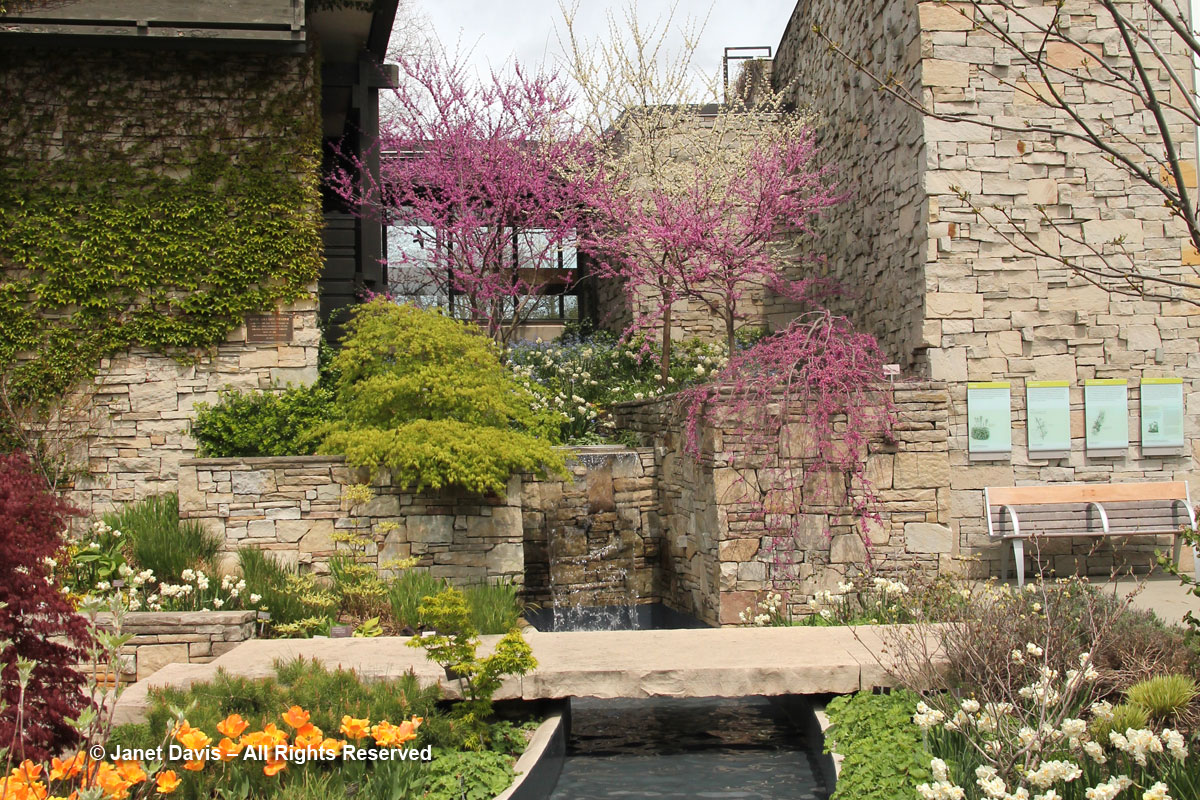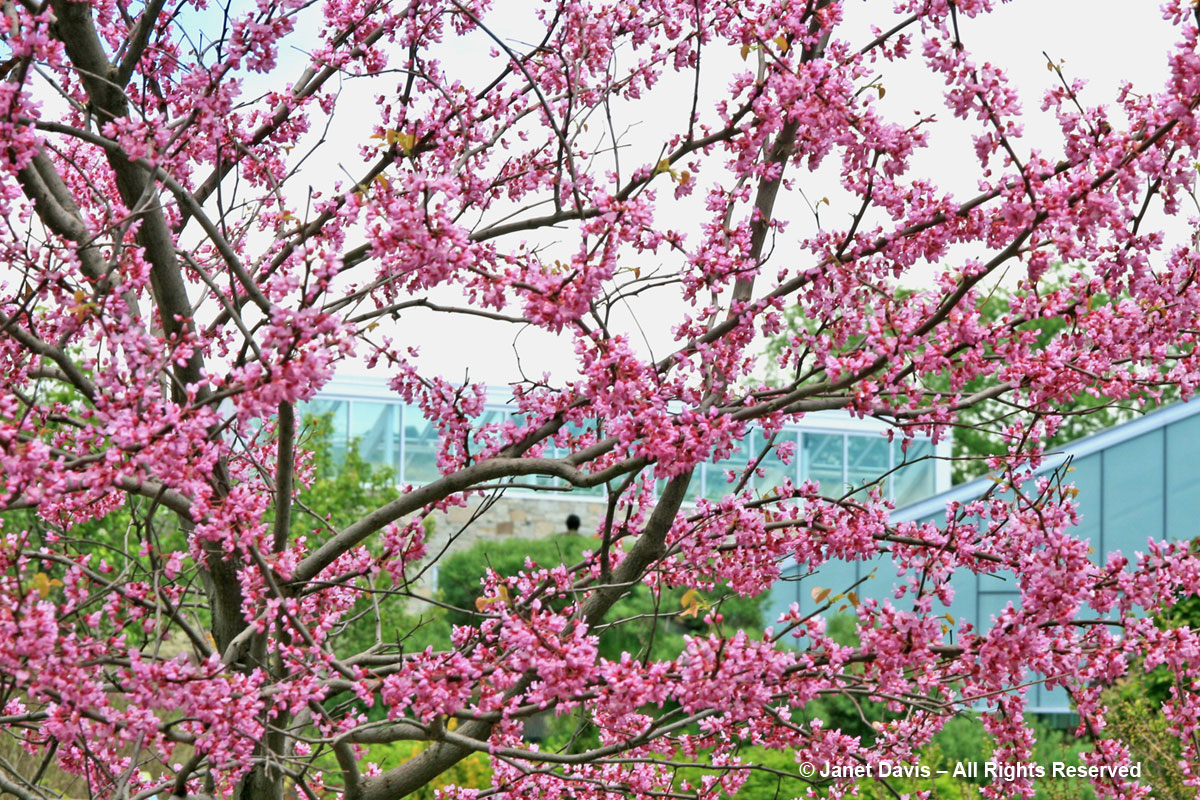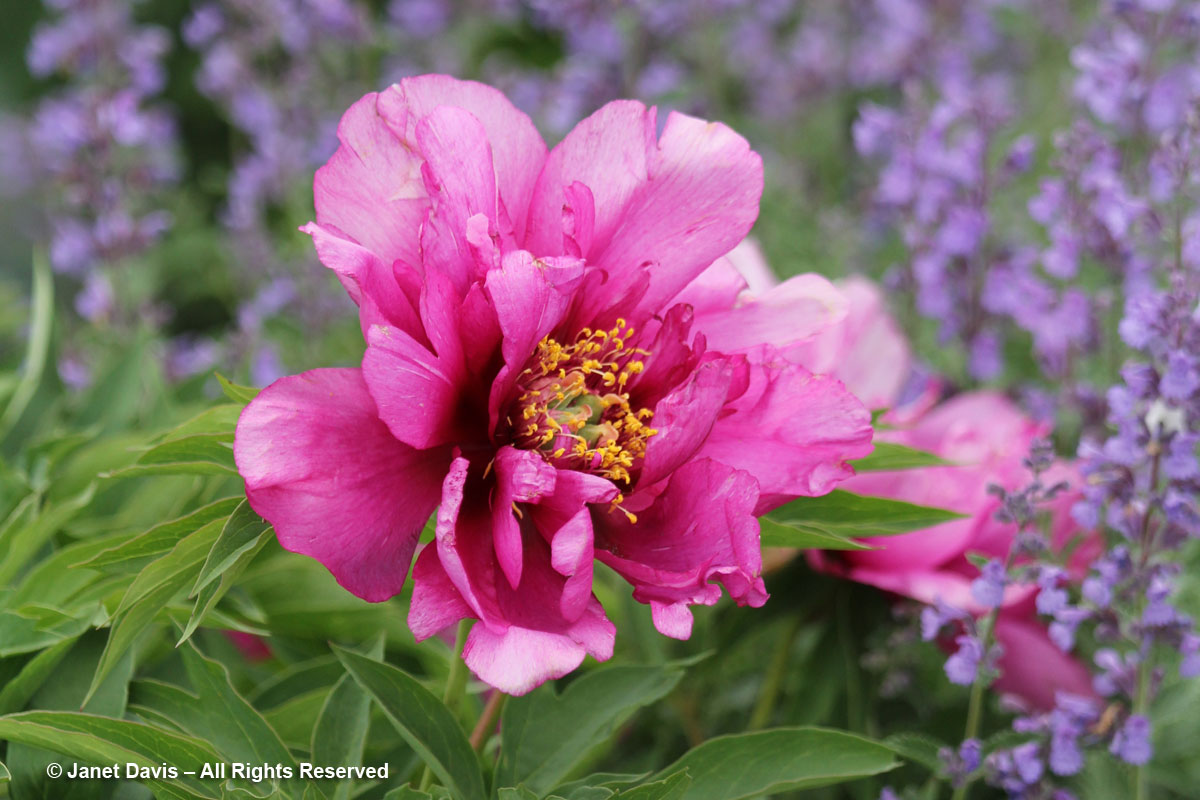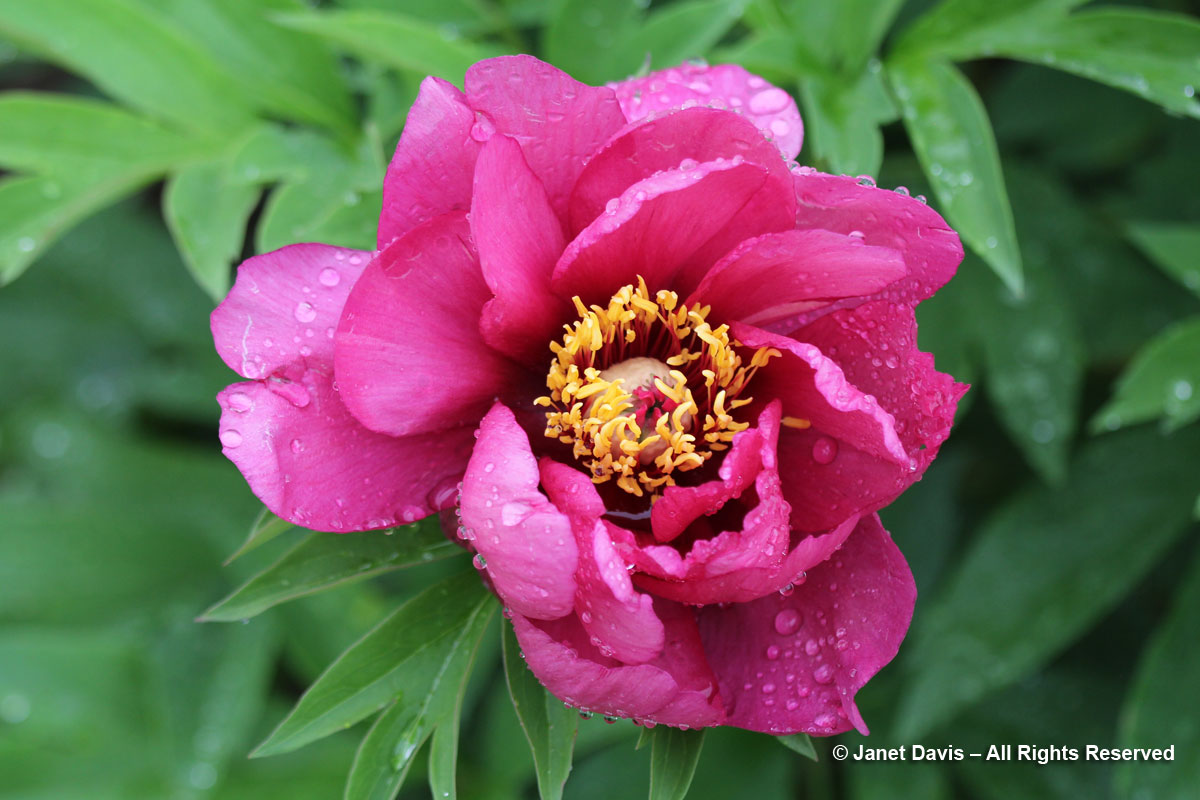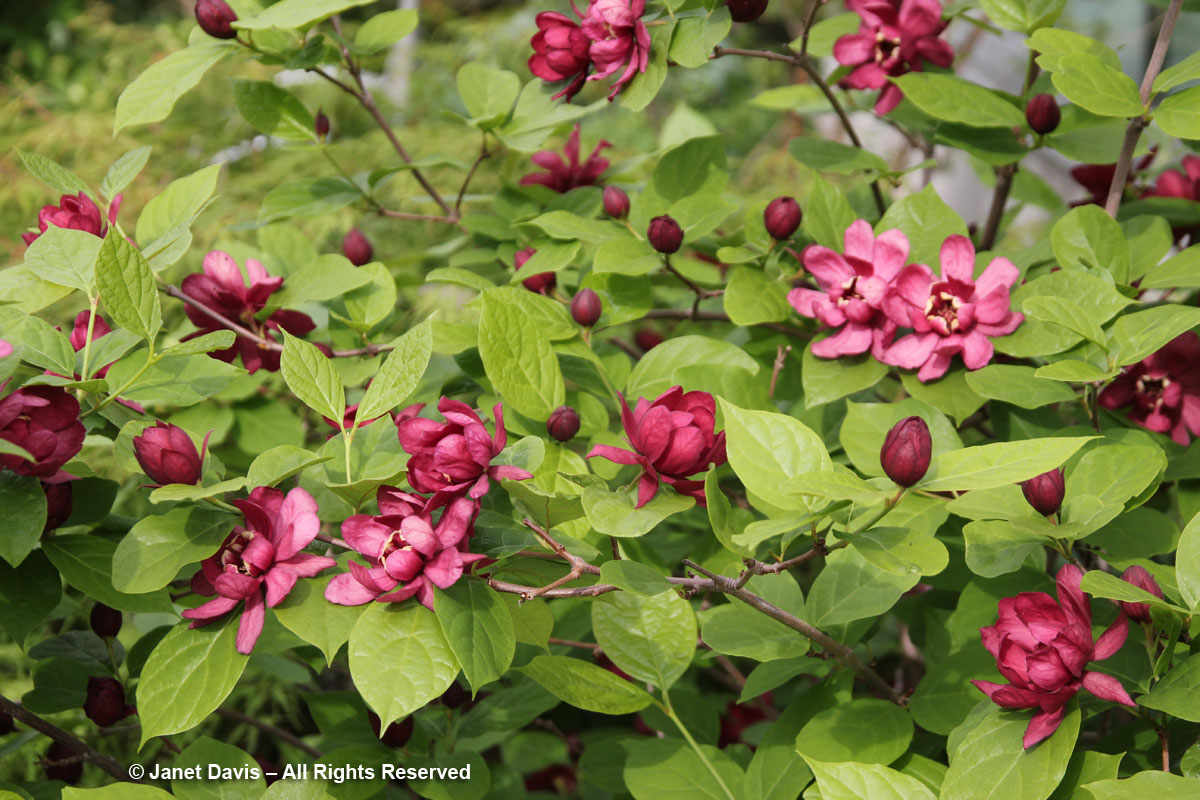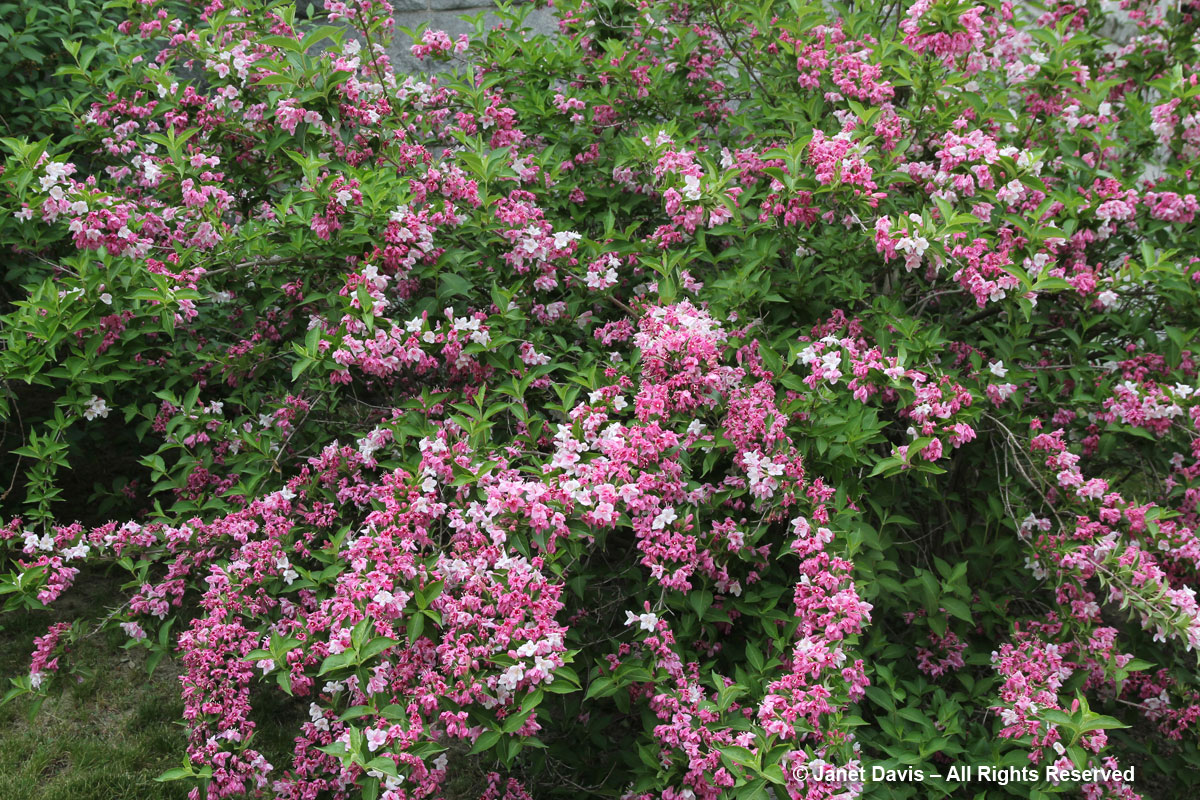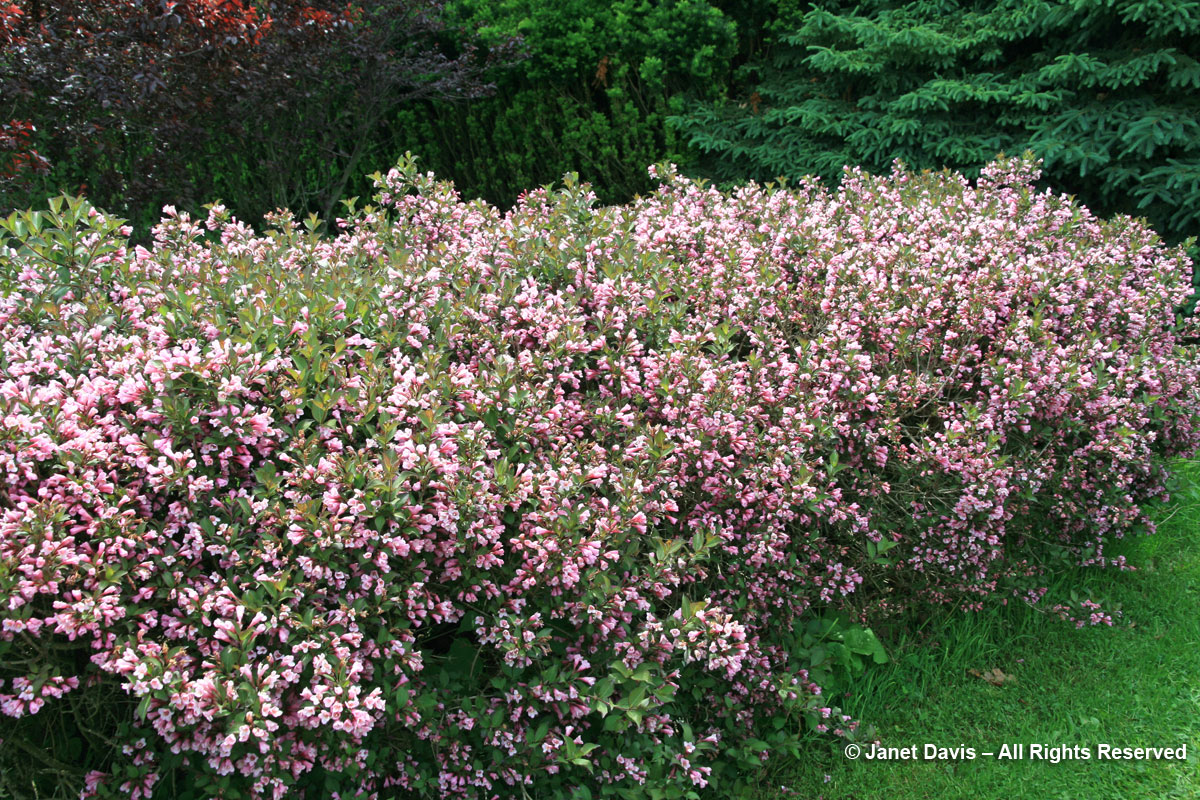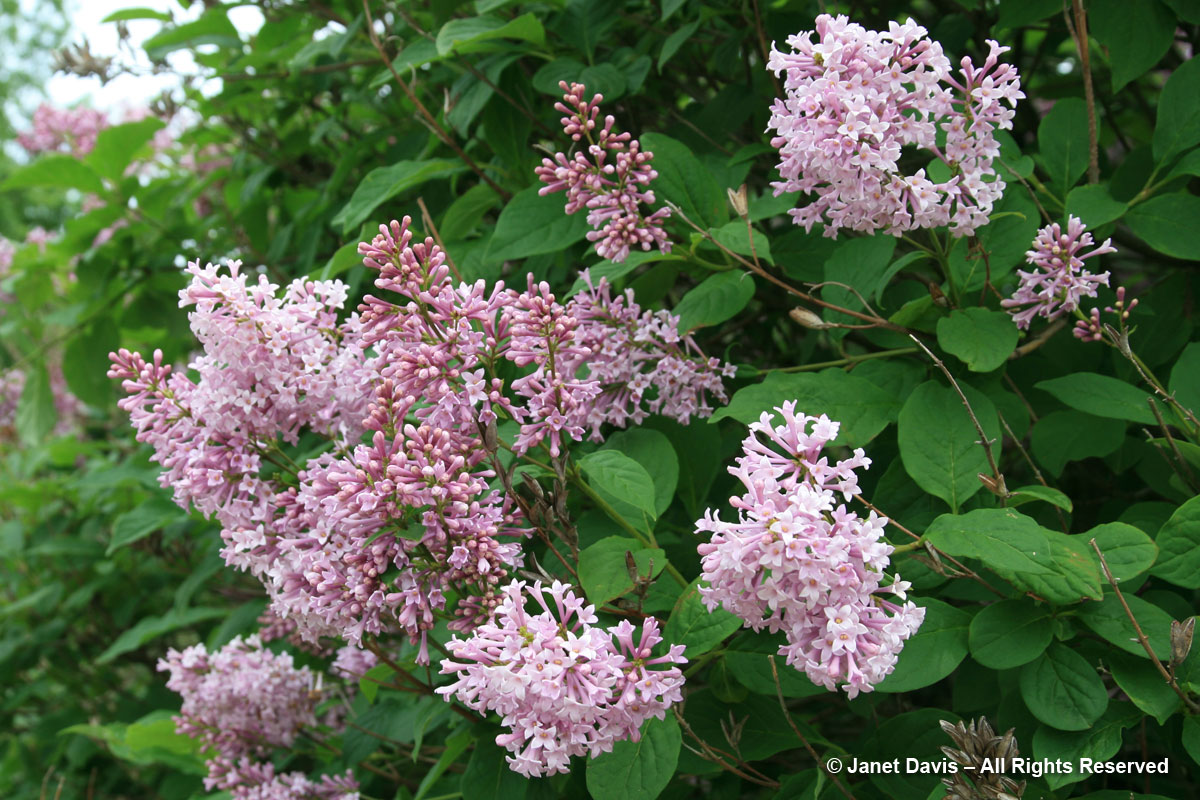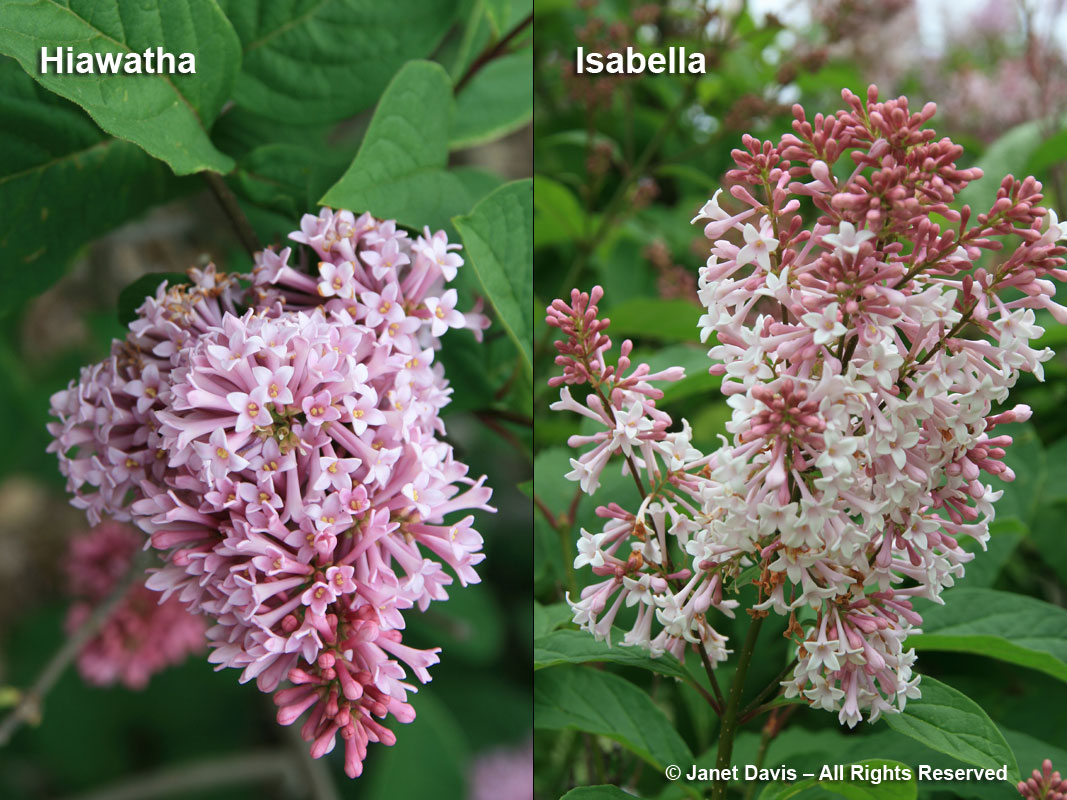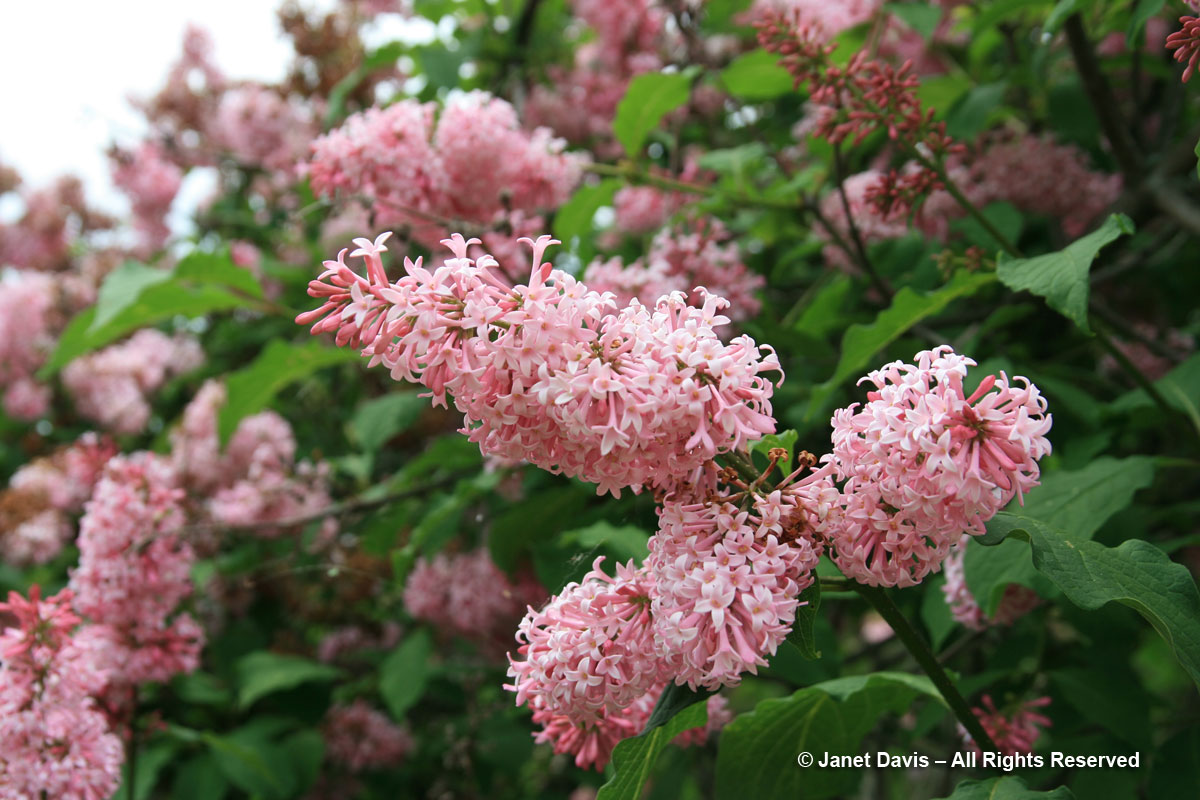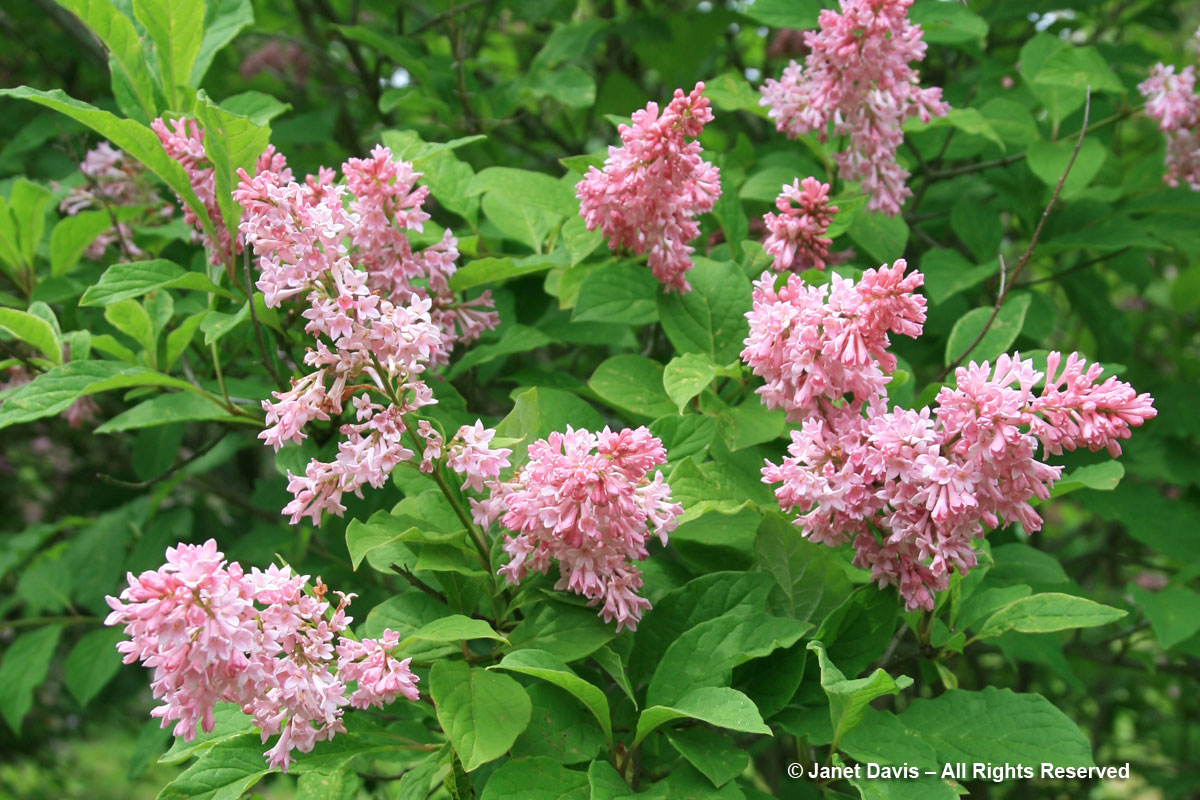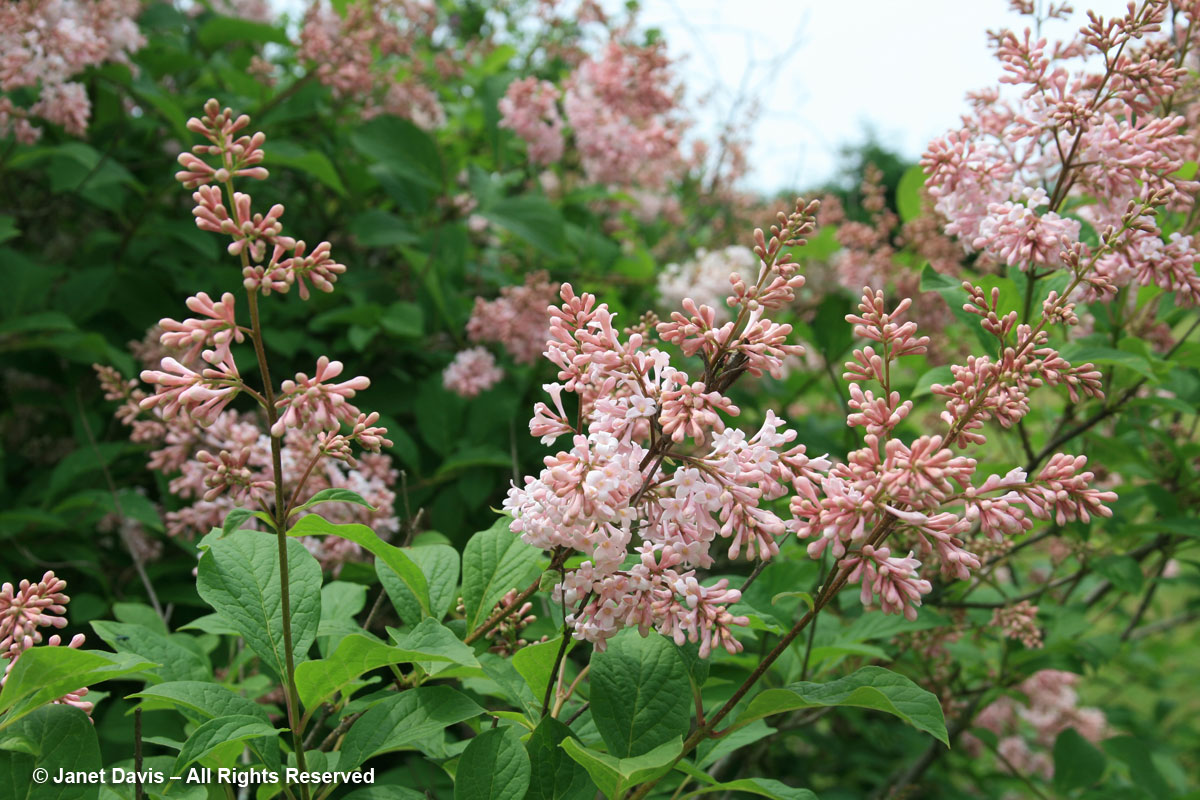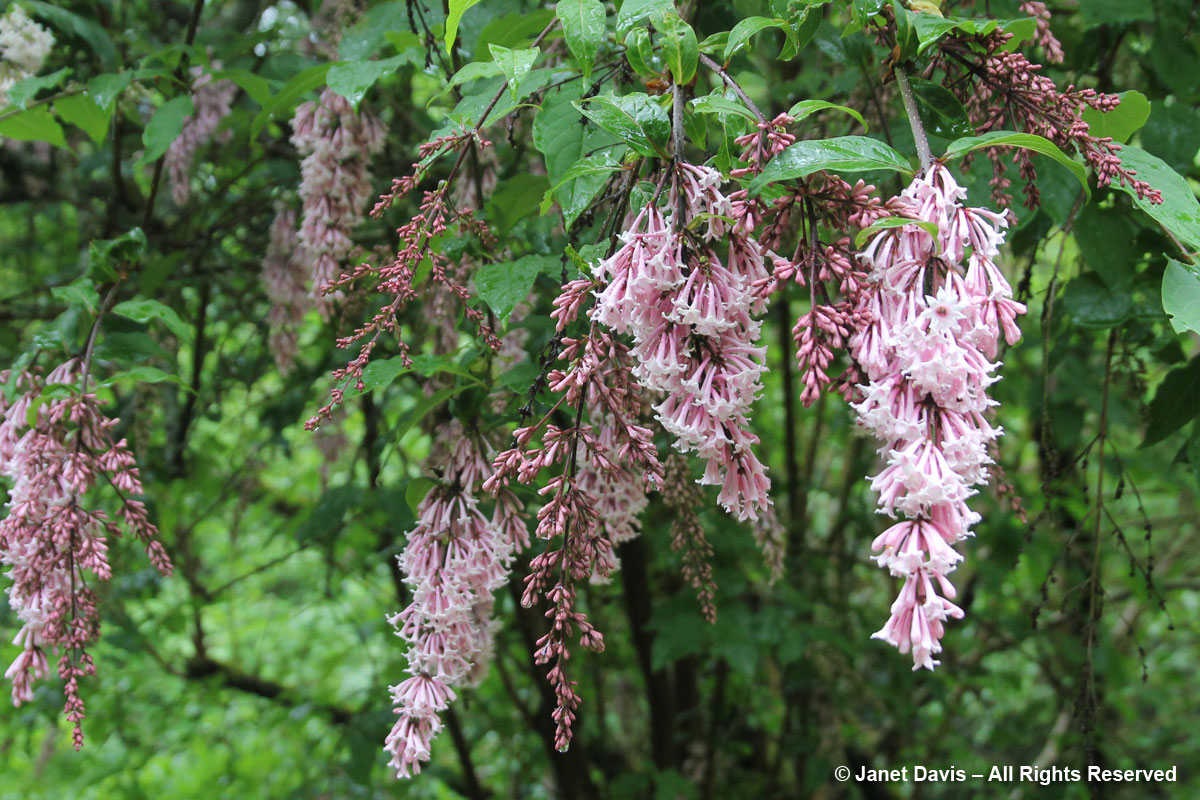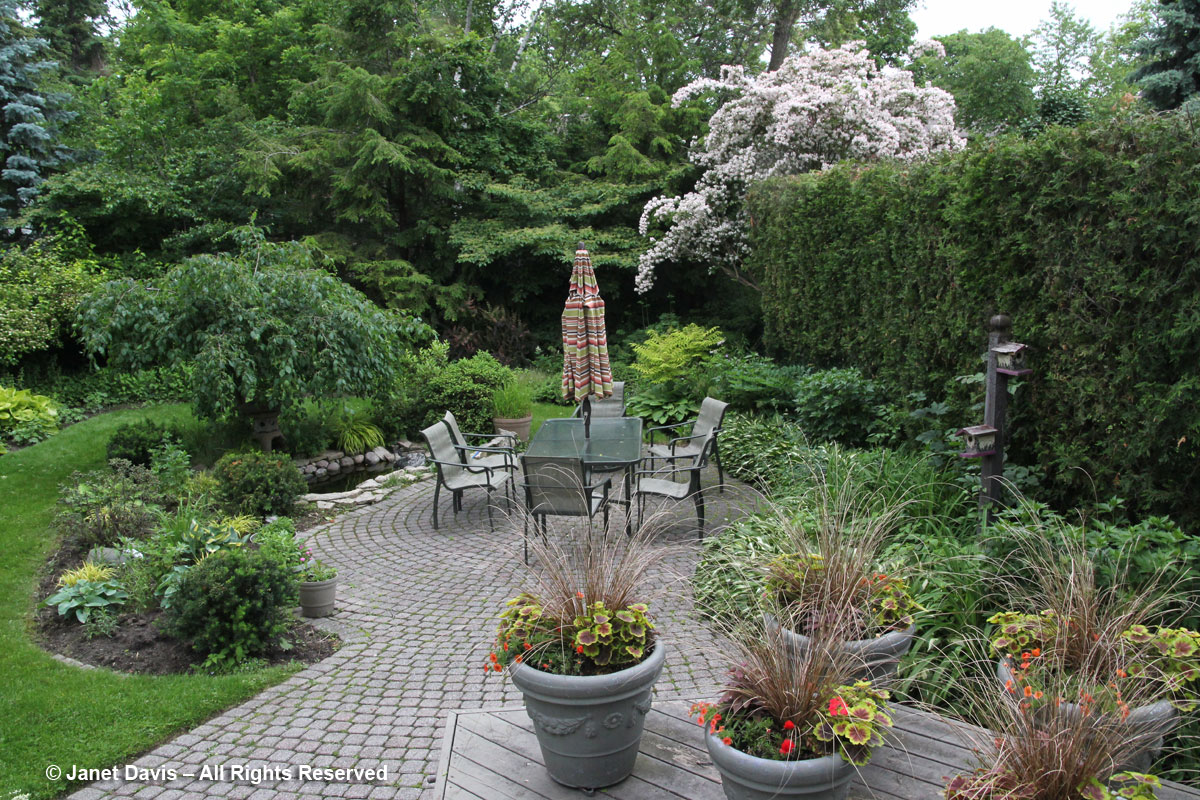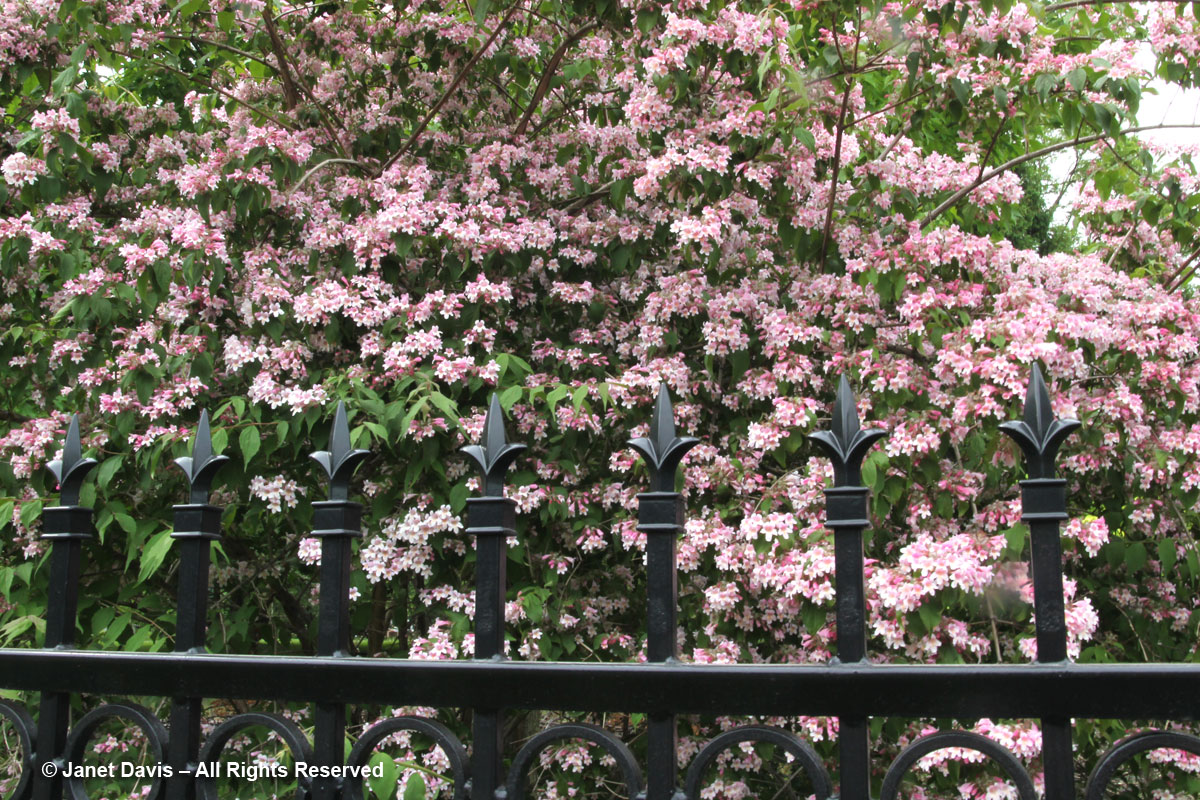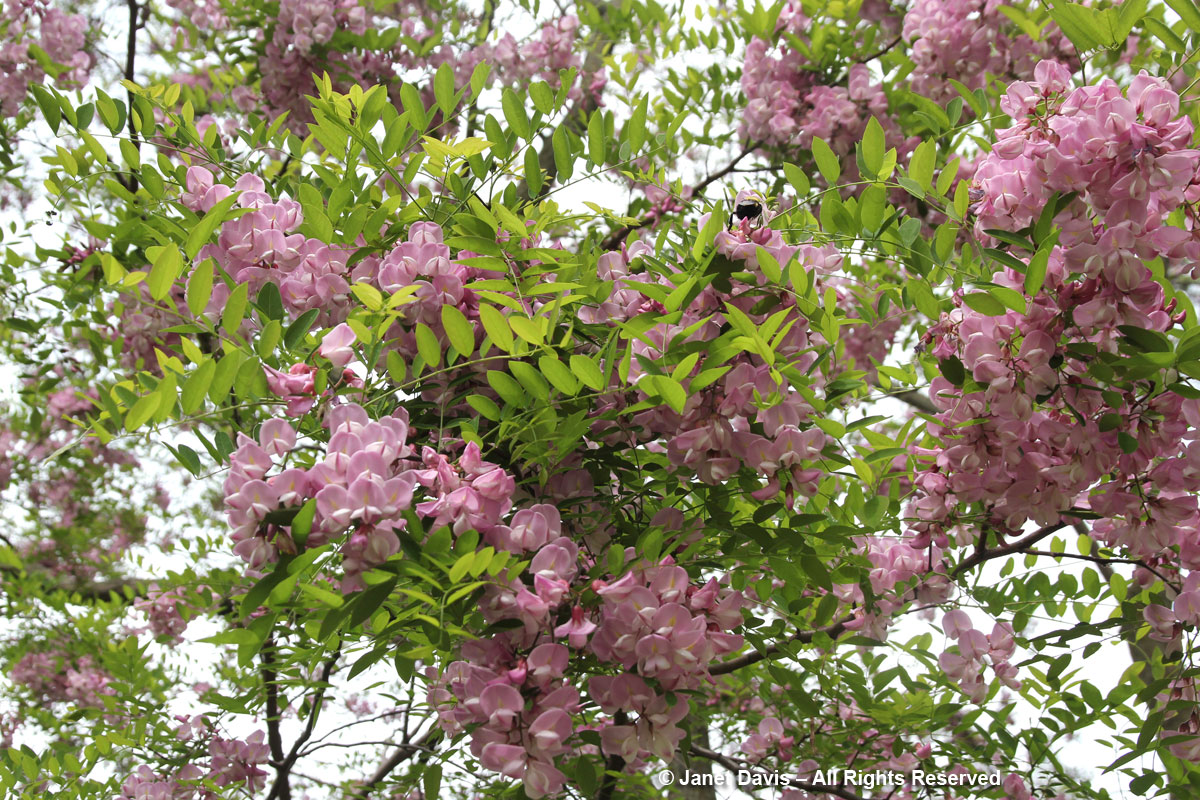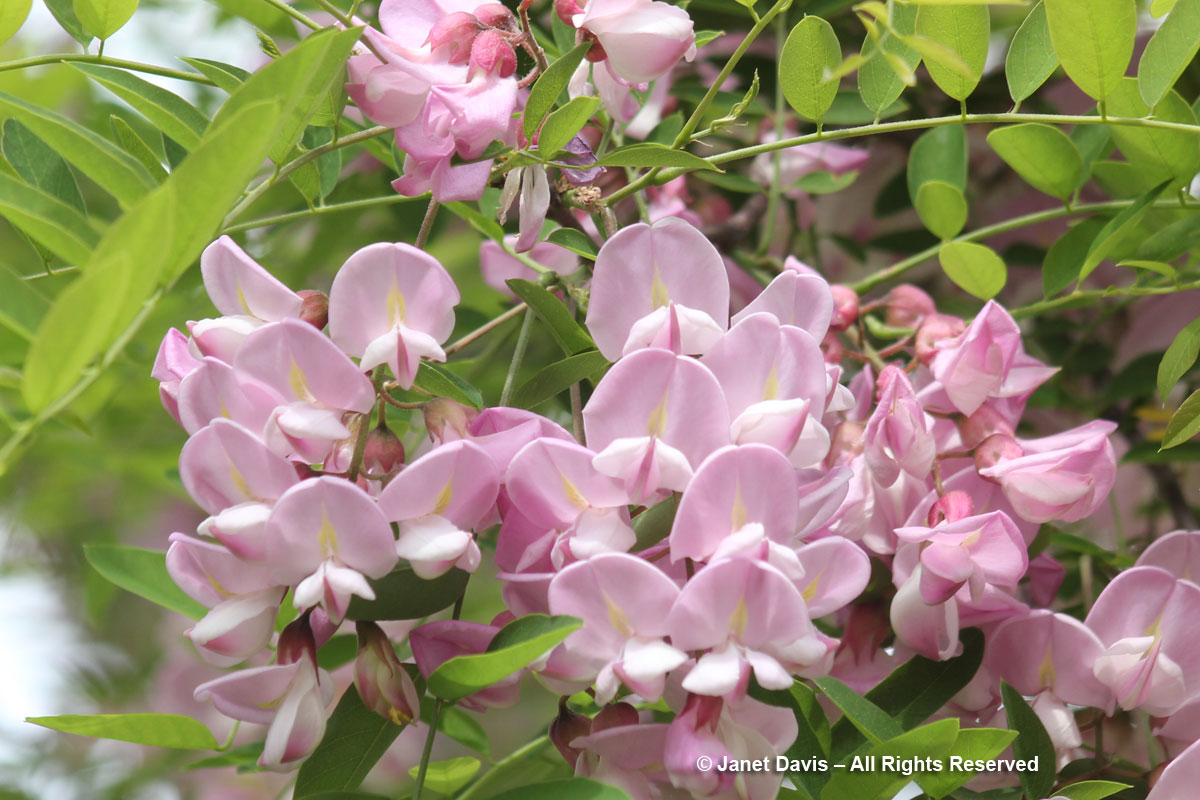Yes, it’s May, and the garden is bursting with fresh spring colour. Greens are still bright, pests haven’t yet made serious inroads, and there’s still a sense of anticipation about what the rest of the spring season holds. And on that note, why shouldn’t it hold some pink? (Especially since I promised you ‘pink for May’ in my 2016 New Year’s resolution!)
The word ‘pink’ is believed to come from the Dutch phrase pinck oogen or “small eyes” and was used to describe flowers of the Dianthus genus that we know as pinks, with their small coloured eyes. Plants like this little Deptford pink (Dianthus armeria) that pops up along my path at the cottage at Lake Muskoka….
….or the common grass pink (Dianthus plumarius), with its deliciously spicy clove perfume and lime-loving ways.
Its use in colour terminology, i.e. ‘pink-coloured’, dates from 1680, referencing the same genus of plants, but increasingly coming to have other meanings and connotations, such as “in the pink” for health, relating to complexion and the 20th century “pink for girls and blue for boys” social construct that saw everything from maternity ward bracelets to toys and furniture divided into two camps. Interestingly, pink and blue are conjoined in Panatone’s 2016 Colour of the Year, which I blogged about a while back.
The use of pink plants in garden design schemes seems to have had its heyday in the 1980s, when pretty pastels and combinations of pink-lavender-purple-blue-silver were popular. That “pink for girls” look subsided considerably over the next few decades, when hot colours, dark foliage schemes and green-on-green designs came into their own. But pink-inflected borders are still lovely, and a hallmark of the June garden, when pink peonies and the complementary blues and purples of lupines, irises and other early-summer perennials create a romantic mood, as they do below at Toronto’s Spadina House.
There are loads of pink-flowered perennials and I’ll tackle some of my favourites another time. But in this blog I want to talk about hardy shrubs and vines with pink flowers. It seems reasonable to do that chronologically, so I’m starting with my favourite pink magnolia, the enchanting and exceptionally early-blooming little ‘Leonard Messel’ Loebner hybrid magnolia. A cross between white-flowered Magnolia kobus and the pink form of star magnolia Magnolia stellata ‘Rosea’, it is very hardy and utterly enchanting, with its starry pink flowers. Put lots of glory-of-the-snow (Scilla forbesii formerly Chionodoxa) under this one!
‘Leonard Messel’ is best in a protected spot away from wind and weather and lovely with the first spring bulbs. However, a killing frost in early spring in colder regions (twice in 10 years in Toronto) will turn those brave flowers brown, so caveat emptor.
Japanese cherry trees (Prunus x yedoensis, P. serrulata, etc.) are an iconic – if fleeting – sign of spring in many parts of the temperate world where sakura flower-watching is enjoyed. In colder regions, like Southern Ontario where I live, the choices are somewhat limited, but there is one that I love for its abundant pale-pink flowering show in late April or early May. Prunus ‘Accolade’, shown below, is a 1952 hybrid from England’s Knapp Hill Nurseries, a cross between a form of Prunus x subhirtella and the very hardy, northern Japanese hill cherry Prunus sargentii, aka ‘Sargent’s cherry’, named for its American collector Charles Sprague Sargent. As a bonus to its flowering, it will also usually turn soft apricot-gold in autumn.
The flowers of ‘Accolade’, below, are exquisite, and arguably the tree is one of the hardiest available for northern gardeners (apart from the early Yoshino cherry, Prunus x yedoensis and the later, double-flowered and rather harsh pink Prunus serrulata ‘Kanzan’). But there’s a little hitch: if winter temperatures flirt with historic lows in the mid-to-low -20s Celsius, the flowers will often blast without opening. Even in a mild winter without excessively low temperatures, if the mercury drops unseasonably in early spring as the buds are plumping up – as it did in Toronto this April – Japanese cherries will not flower profusely; some will not flower at all. But that’s the chance you take.
An early, pink-flowered shrub to consider is Farrer’s viburnum (Viburnum farreri). I have this in my own garden and it sometimes opens in March in an unseasonably warm spring. Even better is the hybrid Viburnum x bodnantense ‘Dawn’, below, which is a 1934 selection by Bodnant Nursery in Wales of their cross between V. farreri and V. grandiflorum.
‘Dawn’ is also favoured for its early nectar by bees and overwintering butterflies like the mourning cloak.
Rhododendrons are a mainstay of the milder west coast and the warmer regions of the northeast into the Carolinas, but there are many that are perfectly hardy for us here in USDA Zone 5 (Zone 6 Canadian zones). Among the best pinks are the ultra-hardy, small-flowered rhododendrons bred by Weston Nurseries in Massachusetts. Indeed, I once had eleven of these – a combination of Rhododendron ‘Aglow’ and ‘Olga Mezitt’ – in my front garden for a spring show that brought the neighbours around to ooh and ahhh. In time, the prairie perennials I grew for my ‘second act’ in summer crowded and shaded out these spring lovelies – and in truth, they were never happy with the soil, which was essentially alkaline clay. But they’re highly recommended for people who don’t mind the somewhat brash neon colour and can’t bear the thought of cosseting the big-flowered rhododendrons to protect them from winter sunshine and resulting leaf dessication. Look how lovely ‘Olga Mezitt’ was, with its pink tulip and blue forget-me-not companions.
A closeup of the beautiful flower truss of ‘Olga Mezitt’.
And here is ‘Aglow’ at the Montreal Botanical Garden. Spectacular, isn’t it, for a shrub that can survive -30F (-30C) unprotected without bud damage?
The Eastern redbud tree (Cercis canadensis) is one of the most beautiful of the native northeast sylva. It seems like a little miracle that those pea flowers should emerge on bare wood, transforming each limb from drab winter brown to brilliant raspberry-pink. This little grouping of redbuds at the Toronto Botanical Garden includes two pinks, a white-flowered form and the weeping dwarf cultivar ‘Covey’.
A closer look at Eastern redbud at the Toronto Botanical Garden.
And here’s a better look at Cercis canadensis ‘Covey’ (trade name Lavender Twist – and don’t get me going on the misuse of “lavender” as a colour term), which seems like it was born to cascade over this stone wall!
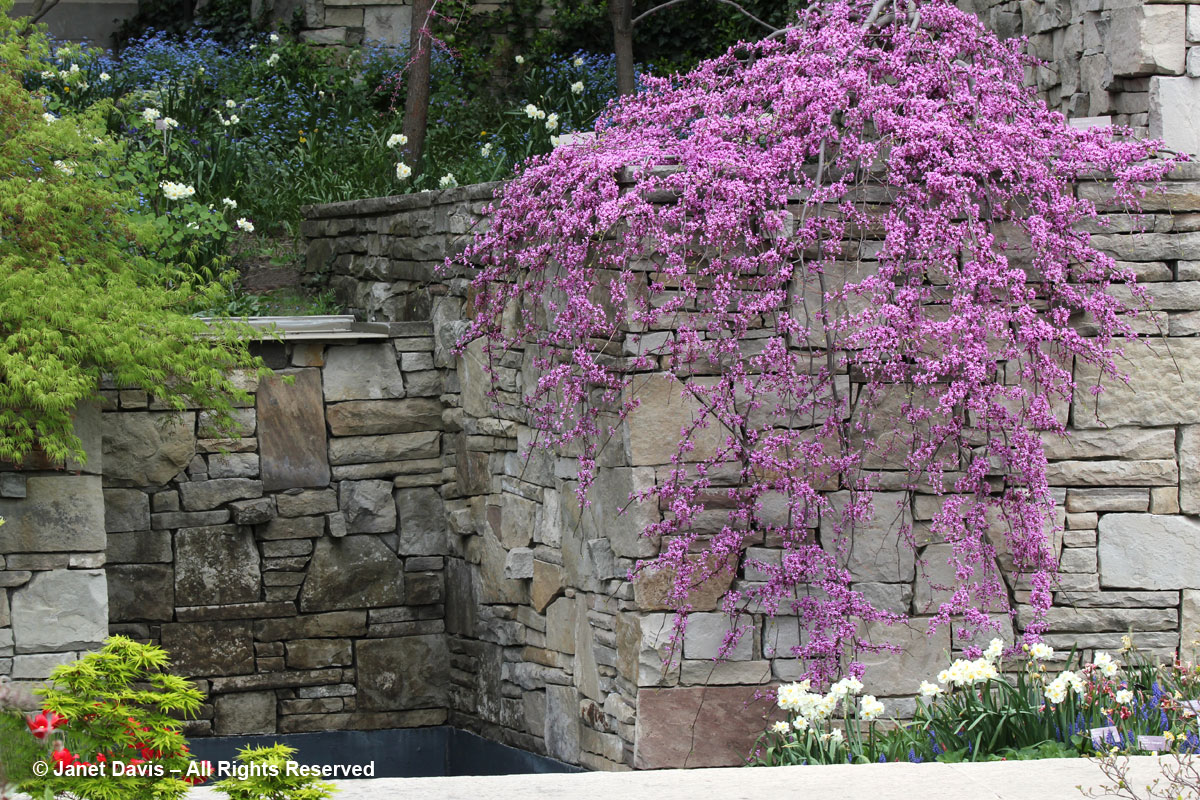
Moving along through spring, we have the gorgeous tree peonies and interspecific Itoh hybrid peonies. You could easily find dozens of beautiful pink tree peonies and Itoh variaeties, but it would be hard to beat Paeonia Itoh Group ‘Morning Lilac’, shown here with catmint (Nepeta racemosa ‘Walker’s Low’).
And ‘Yankee Doodle Dandy’, below, is another beautiful pink Itoh peony.
One of the most elegant, pink-flowered spring shrubs is Calycanthus x raulstonii ‘Hartlage Wine’. This superb selection of a hybrid between Carolina allspice (Calycanthus floridus) and the Chinese species C. chinensis was developed at the North Carolina State University arboretum headed by the late J.C. Raulston. The hybrid honours Raulson, while the selection is named for Richard Hartlage, the grad student who made the cross.
I do know that weigelas (Weigela florida) are not much in fashion these days amongst the horticultural cognoscenti, given that they were much overplanted in decades past. But they are largely problem-free, gorgeous in flower, and quite attractive to pollinators, especially bumble bees. (Incidentally, my friend Rebecca Alexander, erudite librarian at the University of Washington Botanic Gardens Center for Urban Horticulture, points out that the genus should be pronounced VYE-guh-la, since it’s named after German Botanist Christian Ehrenfried von Weigel –and certainly not wuh-JEE-lia. But imagine the looks you’d get at your local nursery as you ask for Vyeguhla!) I think they are lovely shrubs with exciting variety in their flower and leaf colours and forms, especially the beautiful variegated-leaf cultivar ‘Variegata’. Skilful pruning immediately after blooms fade helps maintain a vigorous shrub, but rejuvenation pruning may be required every few years to remove the oldest wood and keep the shrub at a reasonable height.
I’ve also seen weigela grown as an unexpectedly attractive flowering hedge.
Mmm…. lilacs. Everyone loves lilac season, with those magnificent perfumed trusses of the deep-purple, reddish-mauve, white or soft lilac flowers that gave that hue its name. While true pink isn’t seen in the many named lilacs descending from the common lilac Syringa vulgaris, it is found in a class of late-bloomers generally called the Preston lilacs (Syringa x prestoniae). The name honours Isabella Preston, the Canadian plant breeder whose work in the 1920s and 30s with crosses of the late Syringa villosa (shown below) with Syringa reflexa resulted in so many excellent and hardy shrubs, mostly known as the Villosae Group. Lightly-scented (of privet, rather than the typical lilac scent), they flower 10 days to 2 weeks after common lilacs.
Other breeders worked with these lilacs too, such as Dr. Frank Skinner in Roblin, Manitoba, who developed the beautiful pink-flowered ‘Hiawatha’, on the left below, in 1932. On the right is ‘Isabella’, developed in 1928 by its namesake Miss Preston.
Syringa x prestoniae ‘Miss Canada’ was introduced, appropriately, in Canada’s Centennial year 1967, by Dr. William Cumming at Manitoba’s Morden Research Centre, a cross between Syringa josiflexa ‘Redwine’ and S. x prestoniae ‘Hiawatha’, above. What a pink beauty she is.
Syringa x prestoniae ‘Ferna Alexander’, was introduced in 1970 by Boston horticulturist John H. Alexander, who recommended appreciating these late lilacs for themselves as exceptional shrubs, rather than comparing them to the familiar common lilac and its selections. I photographed this rare beauty at the top of the Lilac Dell at the Royal Botanical Garden, Hamilton, Ontario, on June 10, 2011. It’s named for the grandmother of current Arnold Arboretum plant breeder J.H. Alexander III, so a tip of the hat to the breeding talents of the Alexander family.
Here’s another beautiful pink Preston from John H. Alexander – ‘Alexander’s Aristocrat’. It seems to me that the RBG and other lilac gardens should be propagating these unusual introductions and making them available in commerce so we don’t lose them for future generations.
Finally, while I’m immersed in pink lilacs — and I could go on and on with pink Prestons I’ve photographed: ‘Alice Rose Foster’, ‘Danusia’, Romeo’, etc. — let me finish up with a beautiful pink, Chinese species lilac from the David Lam Asian Garden at the U.B.C. Botanical Garden in Vancouver (though hardy in cold regions as well): the spectacular Syringa sweginzowii. If that doesn’t knock your socks off, I don’t know what will.
Can you imagine the joy they must have felt at the Arnold Arboretum that day in June 1915 when beautybush (Kolkwitzia amabilis) flowered for the very first time in North America? The seeds had been collected fourteen years earlier near Hubei China by Ernest Wilson, but there was no foretelling that this stunning pink apparition would be the result. Wilson himself was so fond of it, he said: “Among the deciduous-leaved shrubs that central and western China has given to American gardens Kolkwitzia stands in the front rank.” I agree – and feel so lucky that my neighbour planted two beautybush shrubs along our property line, which I get to enjoy as borrowed scenery each June.
Though the species itself tends to be a pale, almost fleshy-pink, the one below in Toronto’s Mount Pleasant Cemetery has the rich colour of the selection ‘Pink Cloud’, a 1946 introduction from the Royal Horticultural Society at Wisley.
My final pink-flowered favourite is Robinia x slavinii ‘Hillieri’, a pretty 1930 selection of the hybrid ‘Slavin’s locust’ developed by New York breeder Bernard Slavin, who in 1919 crossed pink-flowered Robinia kelseyi with the large, white-flowered North American native black locust, Robinia pseudocacia.
With its wisteria-like pink flower clusters much sought out by bumble bees, it’s a lovely sight in early June, though it does bear prominent thorns. I photographed it at Mount Pleasant Cemetery down the road from my home in Toronto, where choice plants have been grown by the arborists on staff for many decades. Sadly, it appears that this tree is not easily found in North America – a shame, really, because it’s a good choice for a small garden.
I could continue indefinitely with pink woody plants for spring, including crab apples, hawthorns, deutzias and, especially, roses (tune in next time for pink clematis & roses). But it’s May, and there’s gardening to be done.

